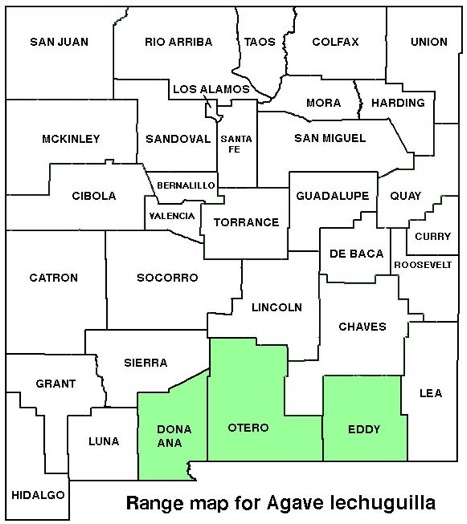WILDFLOWERS OF NEW MEXICO

This dominant, indicator plant of the Chihuahua Desert suckers to form dense colonies with 8–12-inch tall clumps. The sword-like leaf blades, lined with vicious teeth and tipped with a rigid spine, have scared the legs of many a desert traveler. The plant’s uses date back 8,000 years and continue today. Leaf fibers produce cordage and extracts are used in food, soap, and medicine. Note the tall flower stalk lined with reddish, tubular flowers.
FLOWERS: May–June, occasionally anytime. After 10–20 years, the mature rosette sends up a 6–12-foot tall flower stalk (scape) with a spike-like panicle (not branching) with flowers on the upper half; flowers are predominately red, tubular, 1 1/4–1 5/8-inches long (3–4.5) cm. The nectar attracts hummingbirds, wasps, bees, butterflies, and beetles. Reproduction is mostly by vegetative by offshoots.
LEAVES: Dense rosette of 20–50 erect, stiff, fleshy leaves with narrow, tapering, channeled blades 8–20-inches long (20–50 cm) by 3/4–1 5/8-inches wide (2–4 cm); surfaces bright green, margins lined with sharp, downward-pointing teeth; tip with a rigid spine 1/2–1 3/4-inches long (1.2–4.5 cm).
HABITAT: Rocky, limestone soils; desert grasslands and scrub.
ELEVATION: 3,000–4,900 feet.
RANGE: NM, TX; Mexico.
SIMILAR SPECIES: The rosette of narrow, stout leaf blades armed with rigid spiny teeth and the tall, unbranched flowering stalk distinguish this species from other agaves and yuccas in NM and TX.
NM COUNTIES: Extreme southern NM in low-elevation, arid, habitats.

LECHUGILLA
AGAVE LECHEGUILLA (Lechuguilla)
Asparagus Family, Asparagaceae (formerly Agave Family, Agavaceae)
Perennial succulent
THE CONTENTS OF THIS WEBSITE ARE COPYRIGHTED AND CANNOT BE USED
WITHOUT PERMISSION OF GEORGE OXFORD MILLER





EMAIL ME


Vicious spines line the edges of the stiff leaves.
Lechuguillas live for years, then bloom once and die.
Lechuguillas produce numerous “pups” and form dense colonies impossible to walk through.